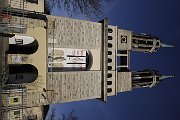Canon EF 28 mm f/1.8 USM
11. Summary
- good build quality,
- very good image quality in the frame centre (apart from the maximum aperture),
- slight distortion,
- low level of vignetting on APS-C,
- silent and quick autofocus.
Cons:
- weak image quality at the maximum relative aperture,
- low resolution at the frame edge of an APS-C and full frame sensor alike,
- quite significant chromatic aberration,
- huge coma,
- unsatisfactory accuracy of the focusing mechanism.
The Canon EF 28 mm f/1.8 USM can be used in two ways. The owners of APS-C reflex cameras will want to use it as a relatively fast standard lens, with the angle of view about 50 degrees. The owners of full frame cameras, for a change, might want to use the tested Canon as a fast, wide angle classic.
Please Support UsIf you enjoy our reviews and articles, and you want us to continue our work please, support our website by donating through PayPal. The funds are going to be used for paying our editorial team, renting servers, and equipping our testing studio; only that way we will be able to continue providing you interesting content for free. |
- - - - - - - - - - - - - - - - - - - - - - - - - - - - - - - - - - - - - - - - - - - - - - - -
Taking into account these two applications, how does the Canon compare with its most dangerous competitors? The Sigma 1.4/30 on a small sensor is undoubtedly one of them. It is a bit faster than the Canon and a bit better at the maximum relative aperture. On stopping down both lenses perform very much alike. At the edge of the small sensor their results are equally weak. To tell you the truth such draws don’t make us happy at all and here you get even more of them because we can say something similar about the chromatic aberration correction as well – both the Canon and the Sigma experience serious problems in this category.
The first victory over the Sigma, although very slight, the Canon achieves in the case of the distortion. When it comes to the coma, once again we see something like a draw - although the Canon’s coma is bigger at the maximum aperture, it disappears more quickly on stopping down. The Sigma 1.4/30 is known for its high astigmatism for a change, so the victory of the Canon in this particular category doesn’t surprise us at all. A very similar story we have with the vignetting. It would be unreasonable to expect a full frame lens to fare worse than a lens by definition designed to work on an APS-C sensor. The situation is reversed with the work against bright light – the Sigma copes significantly better there. What’s more interesting, before the test I would have betted a lot of money on the Canon’s victory in the category of autofocus. After the test procedure, though, my confidence has been seriously shaken.
The summary above shows that the Canon 1.8/28 and the Sigma 1.4/30 are really worth each other and it would be difficult to indicate unambiguously which one is better, especially that both of them cost more or less the same. Some would choose the Sigma because its better fastness and sharpness at the maximum aperture; others will buy the Canon as you can also use it on full frame. They might also buy it for a very mundane reason: they simply trust that a Canon body will cooperate with an in-house lens more efficiently.
In the case of other full frame devices, the Canon 1.8/28 has just one serious competitor with an autofocus system – the Sigma 1.8/28, which has been mentioned already twice in this test. The Sigma is significantly worse than the Canon when it comes to the frame centre resolution but it is better at the frame edge. The Sigma also corrects much better the chromatic aberration and is a bit better at correcting distortion and coma. The Canon’s astigmatism and vignetting are lower for a change. The Sigma works better against bright light. When it comes to the autofocus, both lenses’ achievements didn’t impress us much. The Canon’s small dimensions are its advantage; the Sigma offers shorter minimum focus distance for a change. Once again the choice is not so obvious and I must admit it does surprise me a bit. Before the test I thought that the Canon 1.8/28 would win hands down against the Sigma. It wasn’t the case, though; the results both lenses achieved are, in fact, comparable.
To sum up when you take into account the price of the tested lens, which is not the lowest for such a simple “prime”, Canon ought to show us a successor soon. Full frame digital sensors with the number of pixels reaching over 20 million are too demanding for such an old version of the lens.
Sample shots
Sample shoots, taken with the tested lens on a Canon EOS 550D camera, can be found here.


















